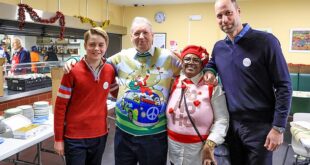Just after midnight, the diesel locomotive rumbled through the sleepy English countryside, en route from Scotland to London. She had twelve wagons in tow. The mail train had left Glasgow at ten to seven, as it did every evening. He was due to reach London-Euston at 3.41 a.m. On board: thousands upon thousands of letters and packages. 75 postal workers sat in this rolling letter station and sorted in piecework. They managed 2000 pieces an hour if they worked hard.
The train belonged to the Royal Mail, more specifically to Her Majesty the Queen. An institution, 44 such mail trains drove through England at night at that time. For 125 years – without major incidents. However, the night from August 7th to 8th, 1963 was to become a little restless. Because the train also had a nice sum of money on board.
At the same time, 16 men were making final preparations on a farm near the village of Oakley in southern England. They put on army uniforms and fatigues, checked that their stocking masks were in their pockets, and went through their plan step by step. Then they grabbed pickaxes, iron bars, and wooden clubs. Shortly after one o’clock the convoy set off in the direction of Sears Crossing, 48 kilometers from London. A convoy of three cars, a three-ton truck and two Land Rovers, disguised as military in the dark. The gang had spied out the place long beforehand, it was ideal for their project.
Ronald “Ronnie” Biggs was in one of the Land Rovers. That he was present at all during the robbery: coincidence. His role: tiny. He jumped up almost at the last moment. But Ronnie Biggs of all people would later become the most famous mail robber in history. For 35 years he would be on the run from Paris to Australia, to Panama and finally to Brazil, where he would become a coveted photo motif, right after Sugar Loaf. His money would be wasted on a failed facial surgery in Paris, false passports and lots of escape helpers.
Of course, Biggs didn’t have the faintest idea about any of that that night. It was his 34th birthday and Biggs was nervous. If the robbery succeeded, he hoped his worries would be gone.
There were £2.6million on board the train, about £57million. euros in today’s value. The gang was well prepared. An electrician should climb up to the signal, cover the green light and flash it “red” with a bulb. That should force the train to stop. A professional racing driver was behind the wheel of a getaway car. For months, the gang members, disguised as anglers, had scouted the area and acted out the robbery.
Money from English and Scottish banks was stored on the train. Before the bank holiday, they had emptied their safes, the money was to go to the headquarters in London: heaps of well-worn one and five pound notes that were to be shredded. A dream come true for robbers, because most of the bills were not consecutively numbered. It was never finally clarified where the gang got the tip from.
That’s 60 years ago. Mail robbers have since gone quite out of fashion. The modern bank robber sits at the computer, hacking accounts or manipulating interest rates. Bank robbery 4.0 is pure screen work. But that didn’t detract from the fame of the mail train gangsters – quite the contrary.
Robbery belongs to capitalism like money, greed and envy. Numerous crimes and their masterminds have achieved notoriety, some even cult status. But Biggs and his buddies set new standards in logistics, management and marketing in their profession – even after their deaths. “The Great Train Robbery” is still considered a masterpiece, the crime of the century. And some of those involved managed to live off the myth of the sympathetic robber who works with brains and without violence for the rest of their lives.
When Biggs died old and ill in London in 2013, obituaries appeared around the world. Even the “Economist” dedicated three pages to the “most famous mail robber in the world”. Only the Queen or the Beatles are more famous in England.
Who was the man who became a superstar, became “the leading mail robber of this century” and stands as a wax figure in the cabinet of Madame Tussauds alongside statesmen and actors?
Nothing in the life of Ronnie Biggs pointed to this “steep” career. Biggs was born in London in 1929 as one of four children; his father was a bus driver. At the age of ten he helped a street gang with petty theft. Biggs was first tried for theft when he was 16. He was put in a reform school, where he began an apprenticeship as a house painter. In 1947 he voluntarily joined the army, tried to desert, was arrested and left the army with a friend. He continued to live from minor burglaries, cigarette trade and tried his hand as a car thief. In between he was caught again and again and ended up in prison.
The life of an ordinary, rather moderately gifted crook. There were many of the sort in London at the time. In the early 1960s, the city had a lively underworld, teeming with pickpockets and frequent thieves. The later mail robbers almost all came from this petty crook milieu. For them, the swindles were always more rewarding than badly paid work.
The average Briton didn’t notice much about Swinging London. In 1963, the majority of Londoners still lived without central heating, cars or washing machines. Long-distance travel was not possible, the food was meager, potatoes, baked beans and the occasional pork, all for a 48-hour week. A worker’s wages offered nothing more. Only a small layer of aristocratic families and the political establishment were rich. They owned almost all of their wealth, lands and palaces.
Biggs would probably have continued his petty crook life with occasional jail stints if he hadn’t shared his cell with Bruce Reynolds, who later became the head of the gang. The two had common interests: jazz, money and women.
Bruce Reynolds, who looked like a cross between Cary Grant and “Mad Men” character Don Draper in photographs, loved expensive cars and had a soft spot for fancy suits, silk shirts and expensive accessories, which his antique shop, which was more cover than business, not threw off. His performance earned the troupe the name “The Gentlemen’s League”. Together with Douglas Gordon Goody, a trained ladies’ hairdresser, he was looking for a quick way to get rich. When they found out about the money being transported on the mail train, they began planning months before the robbery.
Biggs had nothing to do with it. At the beginning of 1963 he was a new father to two young sons, married to the teacher’s daughter Charmian, and for a change he tried work. He ran a small carpentry workshop in London-Redhill. He hadn’t done a crooked thing in three years.
Because Biggs was short on cash, he needed £500 for a house bond, he asked Reynolds. He waved it off, but said that he would soon be making money. The preparations for the raid were soon complete. The gang was only missing a train driver, because despite clandestine driving lessons on a discarded diesel locomotive, the mail robbers were unsure whether they would be able to uncouple the locomotive and money wagon and roll a three-quarter mile to the Bridego Bridge. From there, the money bags were to be loaded onto vans. All this in 15, at most 20 minutes. Half an hour later they wanted to be back in their hideout, Leatherslade Farm. They had rented them through straw men.
When Biggs told his prison pal that he was painting the walls of a retired train driver’s house, Reynolds took notice. But Biggs only wanted to give him the man if he could be there himself. “Biggsy joined the firm by the back door,” Bruce Reynolds later wrote in his memoirs. And: “He played a very insignificant role.” Biggsy should just watch out for his engine man.
But its use went horribly wrong. He almost betrayed the gang when he lit his pipe just before the train arrived. When the train then stopped and one of the robbers hit the engine driver with an iron bar, the substitute couldn’t get the engine to start.
And so, that night, the train driver, Jack Mills, covered in blood, had to drive the train himself. It cost the gang valuable minutes, so they left eight bags of money on the train. The schedule came first. 120 mail bags landed on the railway embankment and were loaded into the three-ton truck and the two off-road vehicles.
The 75 postal workers in the uncoupled cars didn’t notice anything about the robbery, they continued stoically sorting their letters. “From a criminal perspective, the Royal Train was easy prey,” write Nick Russell-Pavier and Stewart Richards in their book about the great mail robbery. Neither the royal post office nor the banks had found it necessary to guard the money train to a greater extent. There were no security guards, no police on board the train. The engine driver and his companion had no way of raising the alarm.
The mail robbers raced back to their hideout at Leatherslade Farm. Biggs and Reynolds sat in the Land Rover and sang Tony Bennett’s hit “The Good Life”. By 3:40 a.m. they were back at the farmhouse, which they had stocked up with weeks’ worth of supplies. Dawn was breaking as the men carried the sacks into the house. Each of the 120 sacks contained £20,000 – each of the 15 men had become a millionaire within 15 minutes.
Biggs was useful primarily as a cook. In their hiding place, he sizzled fine steaks with fries or scrambled eggs with ham, which earned him the nickname “Teaboy”.
While the gang were counting and dividing up the loot in their hideout, Scotland Yard received a call at 4.24am from Euston Control Station that police and an ambulance were urgently needed. The officials informed the local police and initially assumed that there had been a break-in at the station. It was not until 5:08 a.m. that the first police officer, Inspector Mellows, arrived at the scene. But as early as noon, the police said they suspected the gangsters were still nearby, between “30 miles or a half-hour drive” from the Bridego Bridge crime scene.
The mail robbers, listening to the radio and the police radio, got nervous. They decided to leave their hiding place early. Reynolds urged everyone to cover their tracks and yes, don’t leave fingerprints. However, the men did not proceed particularly thoroughly. Twiggy, a skinny fellow, would eventually set the farm on fire. But he was overwhelmed with it.
Lucky for Scotland Yard. The trackers turned the farm upside down, every glass, every teacup, 1000 objects were examined for fingerprints. A comparison with the criminal database yielded nine hits – including Ronnie Biggs and Bruce Reynolds. Biggs’ fingerprints were on a bottle of tomato ketchup and the Monopoly game. With that, the gang had passed the waiting time.
But the robbers managed to escape. Biggs holed up at home. Reynolds hid at the Hilton on Park Lane: “Go first class” if you’re in trouble. “The classier the place, the fewer questions you get asked.”
But just six days after the robbery, police caught the first, convicted with the help of a police officer’s widow, who became suspicious because a man wanted to rent a locker for three months and pay cash in advance. Two weeks later, Biggs was in prison, and by early January 1964 most of the perpetrators and backers had been arrested, except for Bruce Reynolds – he was caught abroad in 1968 – Buster Edwards and three, who were never caught because they were wearing gloves. Ten of the robbers were reported to the police, and their acquaintances were keen on the reward.
The trial began as early as January 1964. It lasted ten weeks and was the longest in English criminal history. On April 16, Judge Edmund Davies sentenced 12 men to a total of 307 years in prison. It took him 28 minutes. Along with six others, Biggs got 30 years for being a “concise liar,” the judge said. Biggs initially denied being involved in the robbery. But when it came out that the nine-time convict was well acquainted with Reynolds, his case was reopened.
In the high-security prison “The Hate Factory” he later had to sew mailbags of all things. In July 1965, a good year after his conviction, he broke out: With a rope ladder, he climbed over the wall of what was said to be the safest prison in England.
After the outbreak, the Daily Telegraph published a letter to the editor from Graham Greene. The writer wrote that he admired the courage and skill of the mail robbers. And he was appalled at the brutality of the penalties: 30 years for a successful thief, but only life (12 years in practice) for the rapist and murderer of a child. “When the legal system punishes a crime against property so harshly, it is not surprising that some feel sympathy for the escapee who, once again, bravely and skillfully avoided such punishment.” That same evening, the BBC asked their viewers if they would reveal the escapee’s hiding place if they knew. The almost unanimous opinion: no.
The great sympathy for the mail robbers was also an expression of disenchantment with politics. Great Britain was still in the shock of the Profumo affair. John Profumo was Secretary of War in the Conservative government. He had to resign in 1963 because of a sex affair with a mannequin believed to be a Russian spy. The affair ruined the government’s reputation, and many Britons questioned the integrity of the establishment. A gang of mail robbers who chutzpah robbed Her Majesty’s mail train were therefore seen as rebels. A state that responded with prison sentences of 30 years as unfair.
When Biggs arrived in Rio in 1974 after years on the run, he had to make money. He had squandered most of his loot, Biggs loved a lavish lifestyle. He was hoping for £35,000 for an exclusive interview with the Daily Mail, but the reporter had police in tow: Scotland Yard Detective Chief Superintendent Jack Slipper. Biggs owed the fact that Slipper had to fly back to London alone to a detail in Brazilian family law: the crook had just become the father of a little Brazilian again. Still, Biggs was barred from working because of his criminal status. He advertised alarm systems, sold coffee mugs and T-shirts with his likeness on them. In between he recorded songs with Phil Collins, Toten Hosen and the Sex Pistols (“No One Is Innocent”).
He wasn’t above anything. For £100 he offered tourists a barbecue with a real mail robber and his Rottweiler “Blitzkrieg”. In 1998, the travel guide “Lonely Planet” wrote that meeting Biggs was the highlight of a visit to Rio (“The Ronny Biggs Experience”). Biggs’ later fame, writes the publicist Dirk Schindelbeck, was primarily the result of “clever and tenacious public relations work”.
In fact, the sheer mass of publications made it clear what kind of marketing machinery the mail train robbery set in motion. For some media companies, the business with the myth of postal robbery probably brought in many millions more than the original loot of the postal robbers.
A whole series of postal robbers wrote autobiographies, Biggs several, and the top hunters at Scotland Yard also wrote thick tomes about the search for the criminal gang and their frustration that most of the loot never turned up again. Again and again the postal robbers themselves – mostly Biggs and Reynolds were behind them – spread new rumors about possible backers, from obscure Nazis who would have financed the coup to Formula 1 icon Bernie Ecclestone. All fictitious to keep the story going.
The mail robbery also provided the basis for a dozen films. In Germany in 1966, the television three-part series “Die Gentlemen bitte zur Kasse” achieved an unbelievable 84 percent rating. To date, the strip is the most successful television film. Actor Horst Tappert made the breakthrough. Tappert was later even friends with the real role model Bruce Reynolds. Singer Phil Collins took on the lead role in 1988’s “Buster.” None other than James Bond actor Sean Connery played the leading role in “The First Great Train Robbery”, the story told the gold robbery of 1855, but the robbery provided the dramaturgy.
The hype even spread to management literature. The “post robber method” is what consultant Hedwig Kellner called her book, which she used to coach executives in German ministries and banks for many years. In it she promised “success strategies for self- and project management”. Biggs declared it a successful model.
And so the story of the post robbery is also a lesson in the path to cult status. Even after the deaths of icons Biggs and Reynolds, marketing continued. Biggs had made sure of that. Shortly before his death in 2013, he said he was proud to be a train robber: one of those “lovable crooks” and “respectable thieves”.
This article first appeared at this point in the business magazine “Capital”, which, like the star, is published by RTL Germany.
Source link



